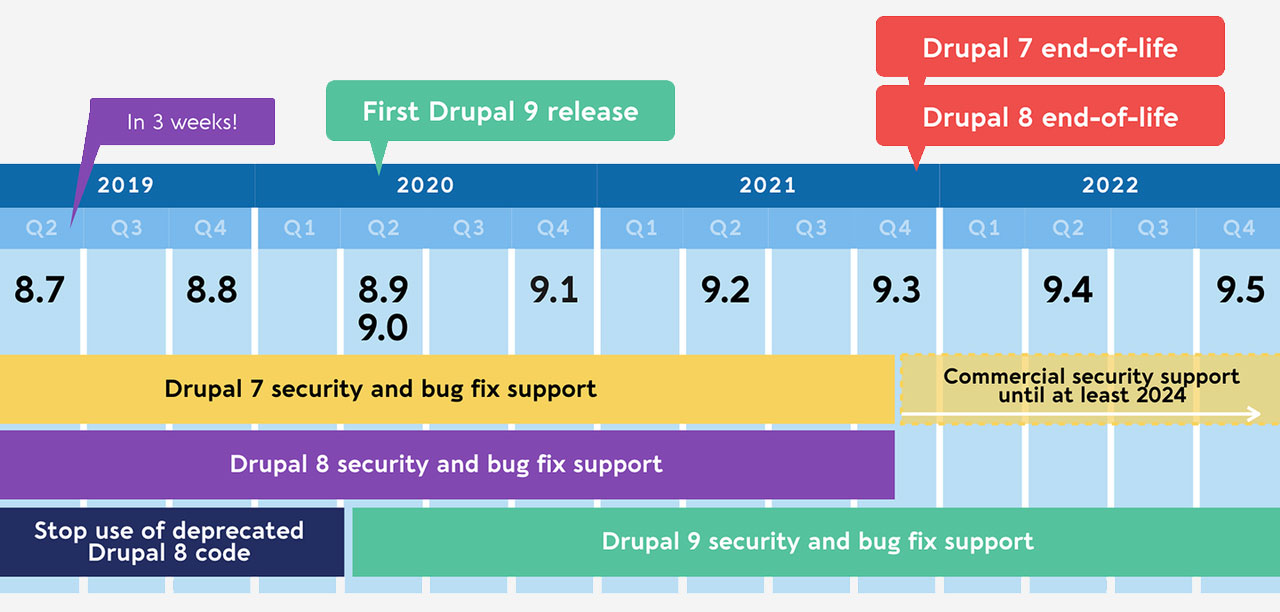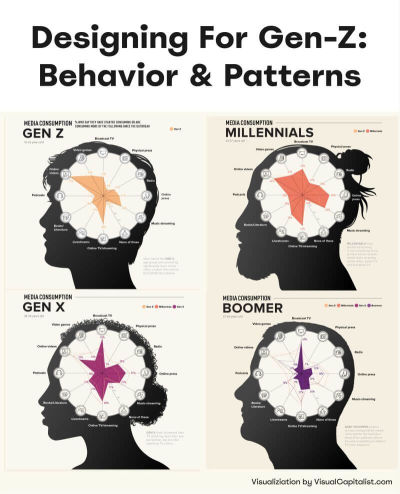Everyone gets excited when their favorite software gets an update! The Drupal Community is currently abuzz about the release of Drupal 9. Wondering what the big deal is? Let’s talk about Drupal and the new improvements. The Drupal project was started 20 years ago by Dries Buytaert in his college dorm room as one of the world’s first Open-Source Content Management Systems. Online years before WordPress or Joomla, Drupal has the distinction of being original GPL code, whereas WordPress and Joomla are “forks” of previous GPL software.
When Drupal began, the internet was a different world. At that point, there were around 50 million websites online, Google was still a private company, mobile browsers weren’t even a concept, and social media didn’t exist. Over the past 20 years, Drupal has become a massive project funded by the parent company Aquia and used by Fortune 50 corporations, governments, and education facilities worldwide. Over 150 countries use Drupal in government and intergovernmental agencies. While WordPress and other DIY CMSs have focused on democratizing websites and content, Drupal set its eyes on a developer’s first experience.
Drupal is not for everyone – and that’s fine. There are thousands of articles comparing the top three open-source CMSs, but the world of open-source CMSs was not meant to be a popularity contest, but instead, it was meant to be tools for developers. Let’s take a quick look at the primary usages of Drupal:
- Corporate websites: NBC, Whole Foods, BBC, Tesla
- Health Care: BlueCross BlueShield, University of Missouri Health Care
- Higher Education: Harvard University, University of Virginia, Rice University
- Government: Australian Government, NASA, NOAA Fisheries, Louisville Water Company
- Fintech: Mediacorp, Harlow Council
- Sports: Major League Soccer, NBC Sports
- Retail: Ashley Stewart, Panasonic
It’s relatively apparent that Drupal is focused on enterprise websites. Drupal 8 has made a lot of advancements to lower the learning curve for designers and looks to be doubling down with Aquia’s acquisition of Cohesion – a drag and drop website builder for Drupal. Easing the curve for WordPress users, the popular WordPress Gutenberg editor was also released for Drupal in 2019.
Drupal 9 to focus on innovations, not features:
Contents
Drupal 9 has been in production for over the past five years and started during the Drupal 8 development cycle. Drupal 9 doesn’t offer any new features upon its initial release but provides a leaner, more secure system with APIs that are easier to work with. These changes will be most noticeable to developers. Future versions of Drupal 9 will continue to feature additions and improvements along the six-month release timeline, established with Drupal 8.
The bottom line for Drupal 9, according to project lead Dries Buytaert, is: “The big deal about Drupal 9 is… that it shouldn’t be a big deal.”
With no new features, Drupal 9 is reinforcing Drupal 8’s focus on making it easier for agencies, marketers, and content creators to use Drupal, while still focusing on developers. The project has also done a lot of work, reducing the cost of ownership, making it easier to upgrade, and making it easier to do security updates. Keeping up with technology, Drupal has also invested in leading innovations around the headless and decoupled CMS.
Drupal for Agencies:
As of Drupal 8, content management has been simplified, making the overall Drupal experience more user friendly. Drupal contains many improvements for front-end developers, including HTML5, additional helper libraries, accessibility enhancements, enhanced base themes, UI elements, and improved performance. Some of the most significant features include:
- Rich Media: Drupal has long supported images and generic files, but 9 expands on this functionality with a generic Media field supporting local audio, video, images, and additional files.
- Content Workflows: The Workflows module allows you to define multiple workflows, show their states, and the transitions permitted between them. The Content Moderation module allows users to create content revisions that are not yet live but have received updates since the last version.
- Layout Builder: The Layout Builder core module provides layout capabilities for content. Layout Builder is unique in offering a single, powerful visual design tool for templated content, custom pages, and templated layouts.
- Multilingual Capabilities: Drupal 8/9 now offers over 100 core languages.
- In-place Editing and Blocks: Most page elements are displayed through blocks, including breadcrumbs, site name, and slogan. This makes it easy to adjust page organization in the user interface and enables in-place front end editing.
Drupal for Developers:
Drupal 8/9 offers numerous backend developer improvements, including object-oriented code, improved caching, better integration with third-party services, and extensive built-in web services features. Some of these stand out features include:
- Migration: Drupal core has built-in support for migrating data to the system from third-party systems such as WordPress.
- Configuration management: Drupal allows for “Development,” “Staging,” and “Production” environments to move configurations between environments seamlessly.
- Headless Support: Drupal ships with an implementation of the JSON:API specification, allowing for the use of Drupal as a central content store on a decoupled front end (mobile application, JavaScript framework, etc.).
What’s new in Drupal 9?
As mentioned above, Drupal 9 will feature all the Drupal 8 features, but under the hood, Drupal 9 will also be an evolutionary advancement over 8.
Here are the top 5 new advancements:
- Drupal 9 will rely on Symfony 4 and require at least PHP 7.3, leading to improved security and stability.
- Drupal 9 moves from Twig 1 to Twig 2 for the templating system.
- CKEditor 4 will ship with Drupal 9; however, CKEditor 5 support is expected in an upcoming version 9 release.
- Drupal 9 will still rely on JQuery, but most JQuery components have been removed from the core.
- Database version requirements will be increased for all supported backends within Drupal 9.
Upgrading to Drupal 9:
Out of all the open-source CMSs, Drupal has been the most complicated to update and involved so many changes that it often required a complete site rebuild. With the introduction of Drupal 8, that has changed, and now upgrading is easier than ever. Users of Drupal 7 and 8 should migrate to 9 over the next year with Drupal 7 and 8 reaching EOL (End of Life) in November 2021.

(Image Source: Dries Buytaert, How to Prepare for Drupal 9 )
Upgrading for Drupal 8 Users:
https://www.drupal.org/docs/9/how-to-prepare-your-drupal-7-or-8-site-for-drupal-9/upgrading-a-drupal-8-site-to-drupal-9
Upgrading Drupal 7 Users:
https://www.drupal.org/docs/updating-drupal/how-to-prepare-your-drupal-7-or-8-site-for-drupal-9
Drupal 9 is currently scheduled for release on June 3, 2020. The first scheduled feature update (minor version) to Drupal 9, Drupal 9.1, is scheduled for December 2020.
As always, if you have any feedback or comments, please let us know. We are here to help in the best ways we can. You’ll find us on Discord, the cPanel forums, and Reddit.

